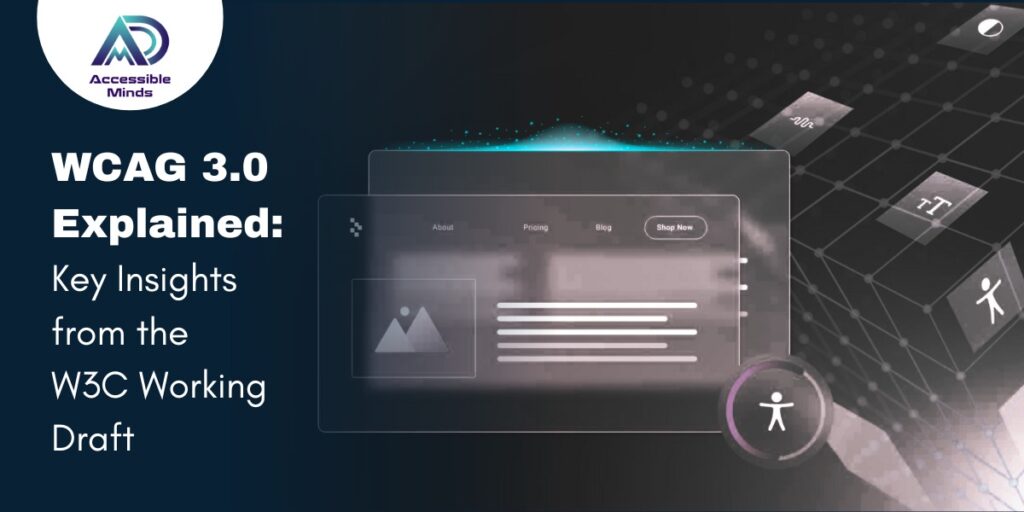Overview
The Working Draft published on 4 September 2025 marks a pivotal moment in the evolution of web accessibility testing standards. WCAG 3.0 continues the legacy of WCAG 2.0 while significantly expanding scope, flexibility, and the underlying model for conformance. It is a living document, not yet endorsed, and designed for iterative development and community feedback.
Goals and Scope
WCAG 3.0 sets out to be more inclusive than its predecessors. It aims to cover a broader spectrum of disability needs, including:
- Visual impairments (blindness, low vision)
- Auditory limitations (deafness, hearing loss)
- Motor and dexterity constraints
- Speech impairments
- Cognitive and learning differences
- Sensory or neurological diversification
Moreover, the guidelines extend beyond traditional desktop environments to include:
- Mobile devices, tablets, wearables, Web of Things (IoT)
- Static, dynamic, interactive, streaming content
- Virtual and augmented reality
- Tools like content management systems, browsers, assistive technologies
Structure: Guidelines, Requirements, Assertions, Methods
WCAG 3.0 adopts a refined, layered model composed of:
- Guidelines: High-level, outcome-oriented statements (written in plain language) that describe accessibility goals.
- Requirements: Normative elements specifying measurable outcomes. Split into:
- Foundational Requirements (for baseline conformance).
- Supplemental Requirements (optional or additional for enhanced accessibility).
- Foundational Requirements (for baseline conformance).
- Assertions: Documented, attributable claims about development or processes aimed at improving accessibility.
- Methods: Technology-specific techniques to fulfill requirements or assertions.
This modular structure allows both flexibility and precision, facilitating filtering or reorganization for instance, by the classic POUR (Perceivable, Operable, Understandable, Robust) categories.
Maturity Framework
Each normative section is labeled with a maturity status to inform reviewers and implementers:
- Placeholder: Temporary content; not intended for feedback.
- Exploratory: Early-stage ideas directional but not yet fleshed out.
- Developing: Rough agreement reached; reasonably formed but open to refinement.
- Refining: Mature content seeking implementation-focused feedback.
- Mature: Candidate material deemed nearly ready for formal recommendation.
Notably, the 04 September 2025 draft contains only material that has reached at least the Developing status exploratory content has been removed.
Conformance Model Overhaul
WCAG 3.0 overhauls the traditional A/AA/AAA model with a tiered and points-based framework:
- Foundational Requirements define the baseline—aligned to WCAG 2.2 Level AA.
- Supplemental Requirements and Assertions allow layering of enhancements.
- Exploration continues into scoring mechanisms such as point systems, percentages, or modular “Bronze/Silver/Gold” tiers.
The model also introduces the concept of “accessibility-supported” techniques, meaning methods must have demonstrated support across real-world user agents. Authors may rely on these methods at the foundational level; at higher tiers, they may need to validate functionality or specify an accessibility support set of tested user agents.
Conformance Scope: Views and Processes
Instead of evaluating whole sites, WCAG 3.0 allows authors to define conformance around views and processes:
- A view refers to a particular user interface or content area.
- A process involves dynamic interactions or workflows (e.g., login, checkout flow).
Conformance can be claimed for one or multiple views/processes. Sampling strategies—important for large-scale, frequently changing content—are acknowledged and slated for future iteration.
Accessibility Considerations Beyond Static Content
The accompanying Explainer document fleshes out background, goals, and testing philosophies. Highlights include:
- WCAG 3.0 inherits portions of UAAG 2.0 and ATAG 2.0, focusing on browsers and authoring tools where relevant.
- Goals include emerging domains like XR (virtual/augmented reality), voice interfaces, and adaptive environments.
- Emphasizes inclusivity in process seeking feedback from a diverse range of people with disabilities.
- Introduces Assertions as traceable claims by developers or organizations about accessibility practices and processes.
- Outlines testing strategies: automated, semi-automated, manual, and assertion-focused tests.
- Articulates a project schedule: the Accessibility Guidelines Working Group (AGWG) is chartered through November 2025, aiming for coverage at least equal to WCAG 2.2 before finalizing the recommendation.
Implications for Developers and Organizations
A Changing Status Quo
WCAG 3.0 does not replace WCAG 2.0 implementation of the latter remains valid. However, organizations aiming for future-proof accessibility should begin exploring the new model.
Path to Conformance
Reaching WCAG 3.0 compliance may begin with existing WCAG 2.2 AA conformance (rough equivalence) and then layering additional features as defined by supplemental requirements and assertion strategies.
Tooling and Workflows
Authoring tools and evaluation systems need to support:
- Tagging and filtering of content by guideline, requirement level, and maturity.
- Mapping and documentation of conformance assertions.
- Tracking of support across user agents and assistive technologies.
Participatory Development
Practitioners and researchers are encouraged to engage with the draft by:
- Reviewing Developingstatus content and submitting feedback via GitHub or email.
- Identifying gaps in research or methods.
- Offering proposals for user-generated content, sampling strategies, or assertion documentation.
Conclusion
The WCAG 3.0 Working Draft (04 September 2025) lays a forward-looking foundation for accessible web content in an increasingly diverse technological landscape. With its layered structure—Guidelines, Requirements, Assertions, Methods—plus a refined maturity model, dynamic conformance approach, and extended device and content scope, WCAG 3.0 is readying the ecosystem for a more inclusive digital future.
Though still evolving, this draft represents a critical step. Developers, accessibility professionals, tool creators, and policy makers should familiarize themselves with its architecture, participate in its refinement, and plan for its adoption in the long term.

